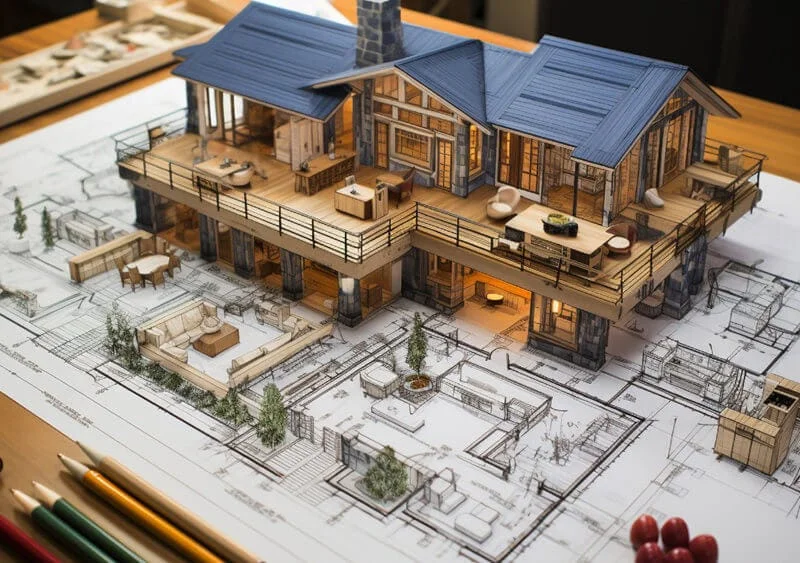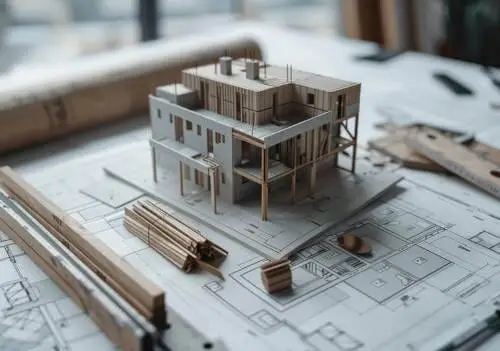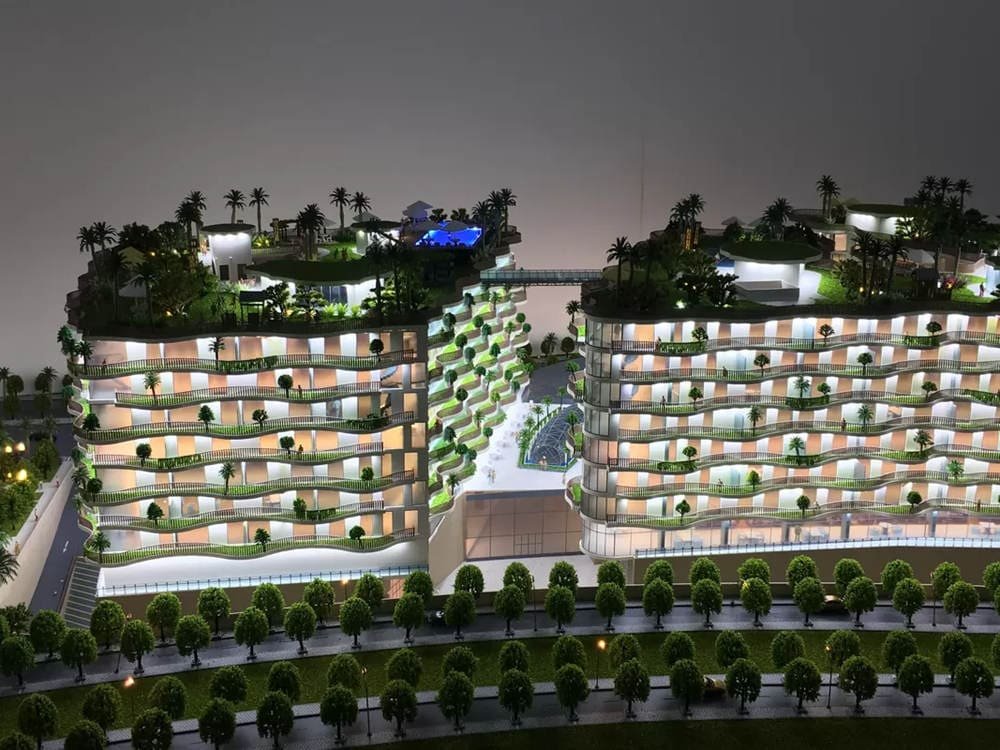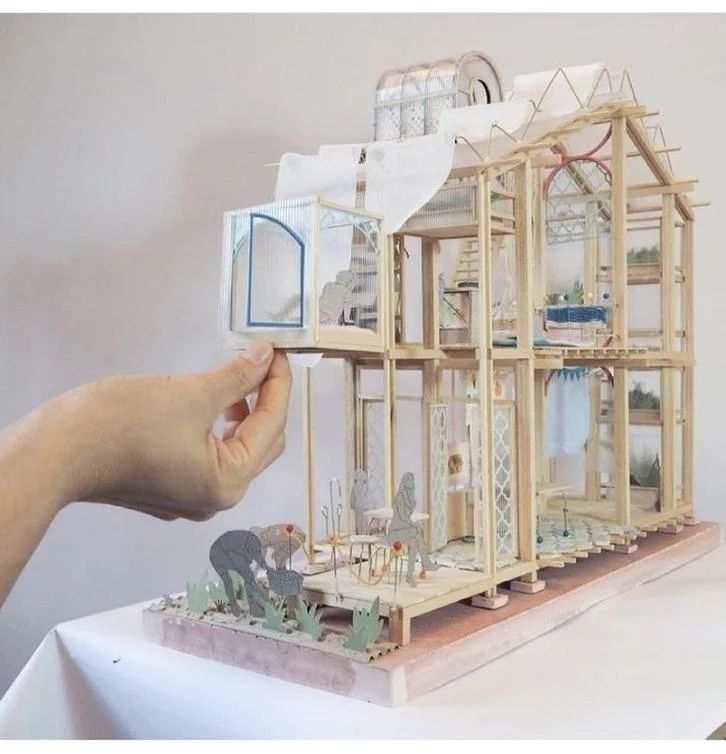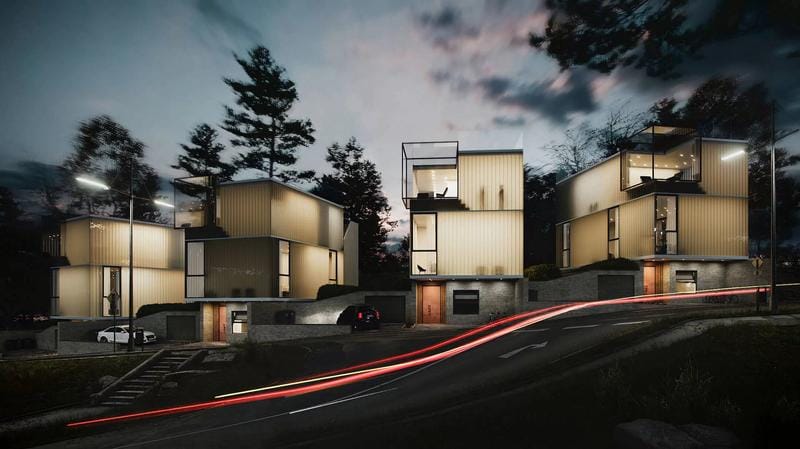جدول المحتويات
ما هو بالضبط النموذج الداخلي? تفريغ المفهوم
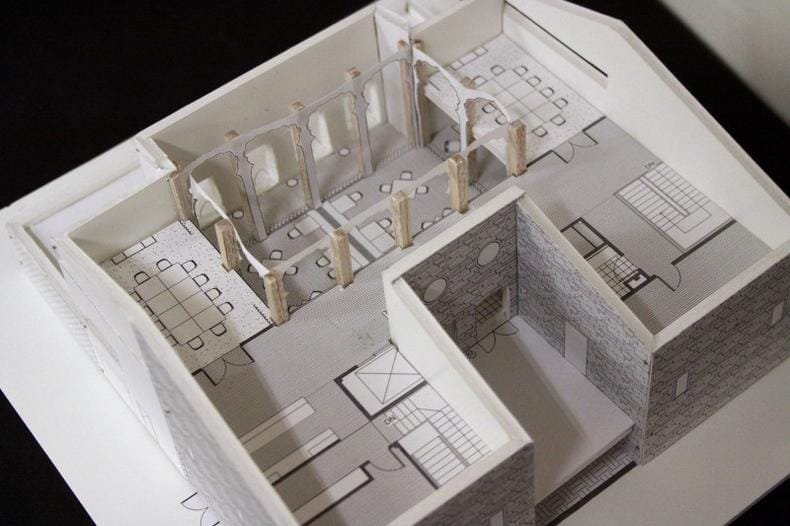
في قلبها, النموذج الداخلي هو نموذج مصغر مادي يركز بشكل خاص على داخل من مبنى أو هيكل. ويعرض ترتيب الغرف, أثاث, المباريات, التشطيبات, والجودة المكانية الشاملة. لكن المصطلح يغطي مجموعة واسعة من الإبداعات.
تحديد النطاق: من المفاهيم البسيطة إلى النسخ المتماثلة عالية التفاصيل
لم يتم إنشاء جميع النماذج الداخلية على قدم المساواة. يرتبط تعقيدها بشكل مباشر بالغرض المقصود منها:
- النماذج المفاهيمية / نماذج رسم: غالبًا ما يتم تصنيعها بسرعة وبمواد بسيطة (مثل الورق المقوى أو الرغوة), تستكشف نماذج المرحلة المبكرة هذه التخطيطات الأساسية, مجلدات, والعلاقات المكانية. إنها رائعة لاختبار الأفكار الأولية والمفاهيم العامة. فكر فيها كأدوات للعصف الذهني ثلاثي الأبعاد.
- نماذج العمل: هذه أكثر تحديدا, دمج معلومات أكثر دقة حول المواد, ترتيبات الأثاث, ومفاهيم الإضاءة. يتم استخدامها خلال مرحلة تطوير التصميم لتحسين الأفكار واتخاذ القرارات الرئيسية.
- عرض تقديمي / نماذج التنفيذ: هذه مفصلة للغاية, نماذج منتهية بدقة مخصصة للعروض التقديمية للعملاء, أغراض التسويق, أو الموافقة على التصميم النهائي. يعرضون المواد, الألوان, إضاءة, وأثاث بدرجة عالية من الواقعية والجاذبية الجمالية. هذه هي النماذج التي غالبًا ما تبهر المشترين أو المستثمرين المحتملين.
- نماذج بالحجم الطبيعي: أحيانا, على نطاق واسع (1:1) أو يتم إنشاء أقسام واسعة النطاق من الداخل لاختبار وظائف محددة, بيئة العمل, material applications, or user experiences directly.
The Core Purpose: Making the Intangible Tangible
Why go to the trouble of building a physical model? Because it achieves things that other methods struggle with:
- Bridging the 2D-3D Gap: Models transform flat floor plans and elevations into a readily understandable three-dimensional space. You can grasp height, عمق, مقدار, and perspective in a way that requires significant interpretation from drawings.
- Visualizing Spatial Relationships: How does the living room flow into the kitchen? Is there enough space around the conference table? How does the light from that window hit the back wall? Models make these relationships immediately apparent.
- Representing Atmosphere and Ambiance: Through careful selection of materials, الألوان, وتأثيرات الإضاءة, يمكن للنماذج أن تنقل الحالة المزاجية المقصودة والشعور بالمساحة بشكل أكثر فعالية من الأوصاف المجردة.
- تسهيل الاستكشاف عن طريق اللمس: القدرة على النظر جسديا, يلمس (بعناية!), والتفاعل مع النموذج يوفر مستوى أعمق من الفهم والاتصال مقارنة بمشاهدة الشاشة.
“يمثل النموذج ثلاثي الأبعاد كيفية فهم العناصر المختلفة أو عملها مع بعضها البعض… [هو - هي] يُترجم إلى لغة مشتركة لا تؤدي إلى سوء الفهم.”
التمييز عن أنواع النماذج الأخرى
أثناء مشاركة التقنيات مع النماذج الخارجية المعمارية أو النماذج الصناعية, تركز النماذج الداخلية بشكل فريد على تجربة حية داخل الفضاء. التركيز أقل على الشكل الخارجي أو العملية الصناعية, والمزيد عن التخطيط, المفروشات, التشطيبات, إضاءة, مقياس الإنسان, والبيئة الداخلية بشكل عام.
الدور الحاسم وأهمية النماذج الداخلية
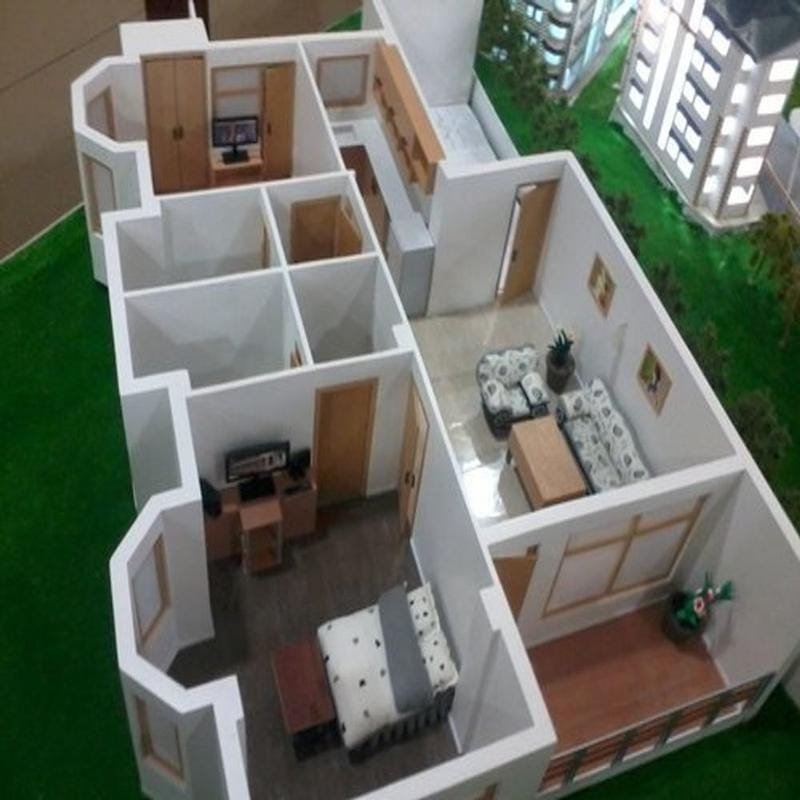
النماذج الداخلية هي أكثر بكثير من مجرد كائنات زخرفية; إنها أدوات أساسية تقود النجاح خلال عملية التصميم والهندسة المعمارية. تنبع أهميتها من قدرتها على تعزيز التصور, تواصل, صناعة القرار, وفي النهاية, جودة المساحة المبنية النهائية.
لماذا استخدام النماذج الداخلية? الفوائد الأساسية في لمحة
إن استثمار الوقت والموارد في إنشاء نموذج داخلي يحقق عوائد كبيرة. فيما يلي لقطة من المزايا الرئيسية:
| فئة المنفعة | ميزة رئيسية |
|---|---|
| تصميم & تخطيط | تحسين التصور & الوضوح المكاني |
| تقييم التصميم الفعال & صقل | |
| الكشف المبكر عن الأخطاء & وفورات في التكاليف | |
| تواصل & ارتباط | التواصل المعزز & فهم |
| زيادة مشاركة العملاء & إشباع | |
| الموافقات التنظيمية للمساعدات | |
| تسويق & عرض تقديمي | تسويق قوي & أداة المبيعات |
التأثير على عملية التصميم
تعد النماذج الداخلية جزءًا لا يتجزأ من الطبيعة التكرارية للتصميم:
- مساعدات تطوير المفهوم: فهي تساعد على ترسيخ الأفكار الأولية واستكشاف التكوينات المكانية المختلفة بسرعة.
- التحقق من صحة التصميم التفصيلي: عندما تصبح التصاميم أكثر تحديدًا, تسمح النماذج للمصممين بالتحقق من الموافقات, خطوط الرؤية, الأثاث مناسب, والتفاعل بين المواد والضوء.
- تسهيل اتخاذ القرارات المستنيرة: من خلال تقديم الخيارات بشكل ملموس, تمكن النماذج كلاً من المصممين والعملاء من اتخاذ خيارات أفضل فيما يتعلق بالتخطيط, مواد, التشطيبات, والأثاث.
- تقليل المخاطر: إن تحديد عيوب التصميم المحتملة أو مشكلات البناء في مرحلة النموذج يقلل بشكل كبير من مخاطر التغييرات المكلفة لاحقًا في المشروع.
ضرورة الوضوح والمشاريع المعقدة
للتخطيطات الداخلية المعقدة, مساحات متعددة المستويات, أو المشاريع التي تضم العديد من أصحاب المصلحة, غالبًا ما يكون الوضوح الذي يوفره النموذج المادي أمرًا لا غنى عنه. إنه يتخطى غموض الرسومات ويضمن مشاركة جميع المشاركين في شيء مشترك, الفهم الدقيق للتصميم المقترح.
العملية خطوة بخطوة لإضفاء الحيوية على النموذج الداخلي
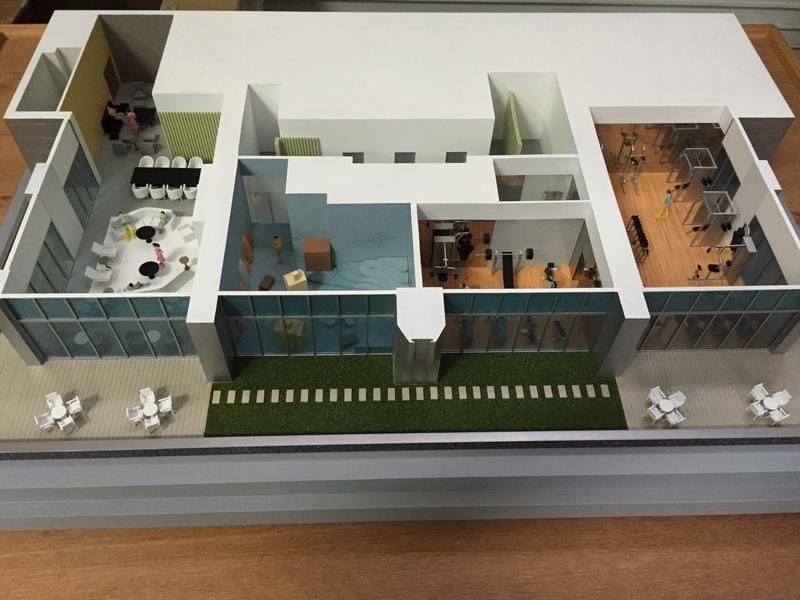
إن إنشاء نموذج داخلي جذاب هو رحلة تتطلب تخطيطًا دقيقًا, التنفيذ الدقيق, وغالبا, مزيج من التقنيات التقليدية والتكنولوجيا الحديثة. دعونا نسير عبر المراحل النموذجية المعنية.
مرحلة 1: مؤسسة التصور والتصميم
مثل أي مشروع تصميم, يبدأ بفهم الأهداف.
- تحديد الغرض والنطاق: ما الذي يجب أن ينقله النموذج? لمن هذا؟? ما هو مستوى التفاصيل المطلوبة (المفاهيمي, عمل, عرض تقديمي)? ما هي الميزانية والجدول الزمني?.
- جمع المعلومات: جمع المخططات المعمارية, الارتفاعات, أقسام, تخطيطات الأثاث, عينات المواد, لوحات الألوان, وأي رسومات أو عروض ذات صلة.
- الرسومات الأولية والتخطيط: تطوير الأفكار الأولية لبناء النموذج, حجم, والميزات الرئيسية.
الدور الحاسم للرسومات والخطط
Accurate source material is essential. الرسومات المعمارية (floor plans, أقسام, الارتفاعات) provide the geometric foundation. Interior design plans specify furniture placement, التشطيبات, and fixtures.
مرحلة 2: Digital Design (اختياري ولكن موصى به)
While not always mandatory for simpler models, using CAD often enhances precision and facilitates fabrication.
- Creating Digital 3D Models: Using software like SketchUp, أوتوكاد, ريفيت, or Rhino, designers create a precise digital version of the interior space and its components.
- Virtual Visualization: Allows for checking proportions, clearances, and generating views before physical construction.
- Generating Fabrication Data: CAD files can directly drive laser cutters and 3D printers, ensuring accuracy in part production.
مرحلة 3: Material Selection – Choosing the Right Medium
The materials used significantly impact the model’s look, يشعر, متانة, والتكلفة. Choices depend on the desired level of realism and the scale.
| مادة | صفات & Uses in Interior Models |
|---|---|
| مجلس الرغوة / فومكور | خفيف الوزن, من السهل قطع, good for walls, الأرضيات, basic structures, نماذج التجمع. White surface takes paint well. |
| كرتون / Cardstock / ورق | Versatile for walls, simple furniture shapes, representing wall coverings, flooring patterns, easy to fold/cut. |
| خشب (البلسا, باسوود, الخشب الرقائقي) | Easy to carve/shape (البلسا), good for furniture, تقليم, العناصر الهيكلية, الألواح. Provides natural texture. |
| البلاستيك (الستايرين, Acrylic/Plexiglass) | Styrene is flexible, good for fine details, تقليم. Acrylic is rigid, clear, great for windows, glass partitions, display cases. Both paint well. |
| 3D Printed Plastics/Resins | Excellent for complex shapes, custom furniture, تفاصيل معقدة, المباريات. Huge variety of materials possible. |
| Fabric / Textile Samples | Essential for realistically representing upholstery, curtains, rugs, bedding. Adds texture and color. |
| فخار / Modeling Putty | Good for sculpting small, unique decorative objects, الأشكال العضوية, or custom fixtures. |
| Paint / ينتهي / Graphics | Crucial for color accuracy, simulating textures (الحبوب الخشبية, بلاط), adding details via printed graphics applied to surfaces. |
Strategic use is key; في بعض الأحيان قد يبدو تمثيل كل نسيج منفردًا تشوشًا. التركيز على المواد الأساسية أو استخدام اللون الأحادي يمكن أن يؤكد على الشكل والتخطيط.
مرحلة 4: التصنيع والبناء – بناء النموذج
هذا هو المكان الذي يأخذ فيه النموذج شكله المادي.
- مكونات القطع: قطع الجدران بدقة, الأرضيات, قطع الأثاث باستخدام السكاكين, مناشير, قواطع الليزر, أو آلات CNC بناءً على الخطط أو بيانات CAD.
- 3د الطباعة: إنتاج مكونات معقدة أو مخصصة مثل الأثاث, المباريات, أو العناصر الزخرفية طبقة بعد طبقة.
- التشكيل والتشكيل: ثني البلاستيك, نحت الخشب أو الرغوة, نحت عناصر الطين.
- تجميع الهيكل: ربط الجدران بعناية, الأرضيات, والأسقف لإنشاء العلبة المكانية الأساسية. الدقة أمر بالغ الأهمية هنا.
الأدوات الأساسية للمهمة
الدقة تتطلب الأدوات الصحيحة:
- أدوات القطع: سكاكين المنفعة, مشارط, مناشير الحلاقة, من المحتمل أن يكون منشارًا شريطيًا صغيرًا أو منشارًا تمريريًا, قطع الليزر.
- أدوات القياس: الحكام الصلب, حكام النطاق, الفرجار, المربعات, أشرطة القياس.
- مواد لاصقة: الغراء الأبيض (بولي) للخشب/الورق, الاسمنت البلاستيكي للستايرين, الغراء الفائق (سيانواكريلات) للسندات السريعة, الايبوكسي للقوة.
- أدوات التشكيل/التشطيب: ملفات, كتل الصنفرة / الورق, ملاقيط, المشابك, التدريبات الصغيرة.
مرحلة 5: التجميع والتشطيب – إضافة الواقعية والتفاصيل
هذه المرحلة تجلب النموذج إلى الحياة.
- تركيب العناصر الداخلية: وضع النوافذ, الأبواب, خزائن مدمجة, and fixtures.
- تأثيث الفضاء: ترتيب الأثاث المصغر بعناية وفقًا لخطة التصميم. قد يكون الأثاث مصممًا خصيصًا, 3د طبع, أو شراء عناصر مقياس مسبقة الصنع.
- تطبيق التشطيبات: طلاء الجدران, تطبيق القوام, إضافة مواد الأرضيات (ورق مطبوع, قشرة رقيقة, طلاء محكم), تمثل أنماط البلاط أو الخشب.
- إضافة ديكور: وضع التفاصيل الصغيرة مثل السجاد, curtains, مصابيح, عمل فني (لوحات مصغرة!), النباتات, والإكسسوارات لخلق شعور بالحياة. “حتى أصغر التفاصيل تحمل وعدًا بالعظمة”
مرحلة 6: تكامل الإضاءة (اختيارية ولكنها مؤثرة)
تؤدي إضافة الإضاءة إلى تعزيز الواقعية والأجواء بشكل كبير.
- تخطيط: تحديد مكان مصادر الضوء (تركيبات السقف, مصابيح, أضواء تحت الخزانة, محاكاة الضوء الطبيعي من خلال النوافذ).
- تكنولوجيا: تُستخدم مصابيح LED المصغرة بشكل شائع نظرًا لصغر حجمها, حرارة منخفضة, وكفاءة الطاقة. يمكن للألياف الضوئية إنشاء تأثيرات خفية.
- الأسلاك: حذرا, الأسلاك المخفية ضرورية, غالبًا ما يمر عبر الجدران أو تحت اللوح, متصلة بمصدر الطاقة (البطارية أو المحول).
- يتحكم: قد يتم تشغيل/إيقاف الإضاءة ببساطة, أو الأنظمة الأكثر تعقيدًا يمكن أن تسمح بتعتيم الدوائر الفردية أو التحكم فيها.
- تأثير: تساعد الإضاءة على تحديد الحالة المزاجية, تسليط الضوء على النقاط المحورية, وإظهار كيفية عمل الضوء الطبيعي والاصطناعي في الفضاء.
مرحلة 7: اختبار, تقييم, والصقل
قبل الانتهاء, تتم مراجعة النموذج.
- فحص الدقة: مقارنة النموذج بالمخططات للتأكد من دقة الأبعاد والوضع الصحيح للعناصر.
- مراجعة مرئية: تقييم الجمالية الشاملة, دقة اللون, جودة النهاية, والواقعية.
- فحص وظيفي (إن أمكن): اختبار أي أجزاء متحركة أو أنظمة الإضاءة.
- صقل: إجراء التعديلات اللازمة بناءً على المراجعة – لمس الطلاء, ضبط وضع الأثاث, إصلاح أي عيوب البناء.
مرحلة 8: العرض النهائي والحماية
- تنظيف: التأكد من خلو الموديل من الغبار وبصمات الأصابع.
- القاعدة والغلاف: غالبا ما يتم تركيبه على قوي, قاعدة جيدة المظهر. غطاء أكريليك شفاف (بيربيكس) كثيرا ما يستخدم لحماية النموذج من الغبار والأضرار, وخاصة بالنسبة لنماذج العرض.
- التصوير الفوتوغرافي / التوثيق: - تصوير الموديل بشكل احترافي (انظر القسم التالي) أمر بالغ الأهمية لأغراض المحفظة والاتصالات.
- التسليم/العرض التقديمي: نقل النموذج وتقديمه بأمان إلى العميل أو الجمهور المستهدف.
الخصائص الرئيسية التي تحدد الطرازات الداخلية عالية الجودة
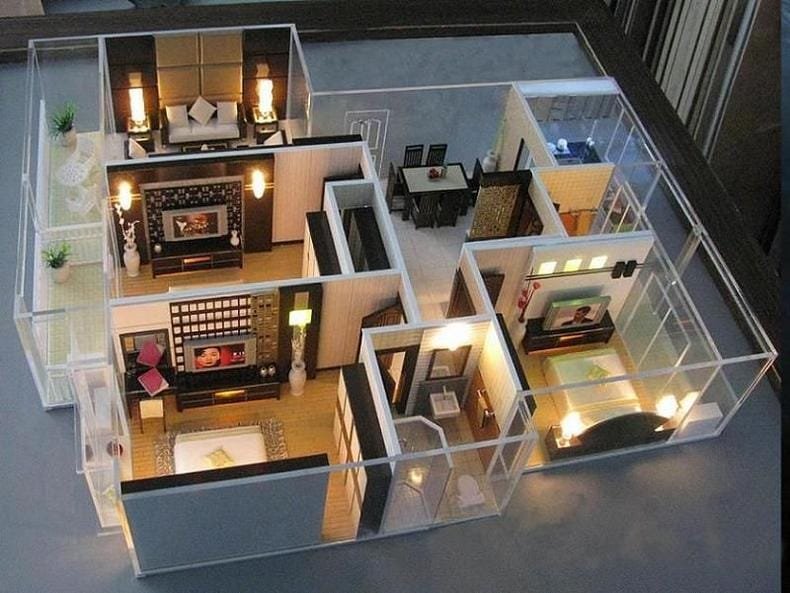
يمتلك النموذج الداخلي الناجح العديد من السمات الرئيسية:
- مقياس دقيق ونسبة: يمثل بأمانة علاقات الحجم بين الغرفة, أثاث, والمقيمين.
- مسح التمثيل المكاني: ينقل التخطيط بشكل فعال, مقدار, الدورة الدموية, والشعور بالمساحة الداخلية.
- مستوى التفاصيل مقنعة: يتضمن التفاصيل المناسبة في الأثاث, المباريات, التشطيبات, والديكور لنقل نية التصميم بشكل واقعي.
- واقعية المادية والملمس: يستخدم المواد والتشطيبات بمهارة لمحاكاة مظهر وملمس أسطح العالم الحقيقي.
- تكامل الإضاءة المدروس (إذا تم تضمينها): الإضاءة تعزز الواقعية, يحدد المزاج, ويصور بدقة تأثيرات الإضاءة.
- مستوى عال من الحرفية: يعرض البناء النظيف, التجميع الدقيق, flawless finishing, and overall attention to detail.
- Durability and Presentation: Well-constructed on a stable base, often with a protective cover, suitable for display and handling.
The Multifaceted Benefits of Utilizing Interior Models (الاستكشاف التفصيلي)
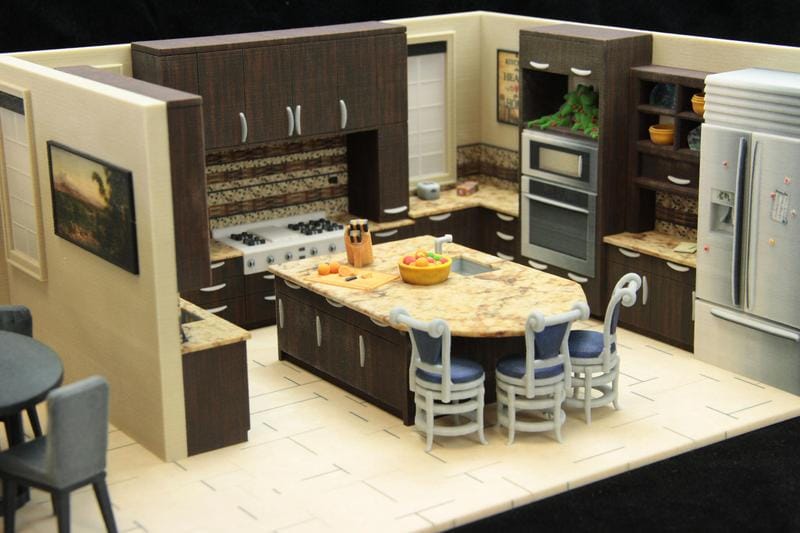
Let’s expand on the advantages of incorporating interior models into the design and communication workflow.
Benefits in Design, تخطيط, and Problem Solving
- Unparalleled Visualization: Models offer an intuitive grasp of three-dimensional space that flat drawings struggle to convey. You can immediately see ceiling heights, room volumes, and how light plays within the space.
- Early Identification of Design Flaws: Awkward furniture placement, insufficient clearance, poor sightlines, or conflicting design elements become readily apparent in a physical model, allowing for correction before costly construction. تخيل أنك تدرك أن أرجوحة الباب تتعارض مع الأثاث *قبل* أن ترتفع الجدران!
- اختبار التخطيطات والتدفق: يوفر الترتيب الفعلي للأثاث المصغر أو تتبع مسارات التداول داخل النموذج رؤى لا تقدر بثمن حول وظيفة وكفاءة التخطيط.
- فهم المقياس والنسبة: النماذج تجعل الأبعاد المجردة ملموسة. يمكن للعملاء والمصممين الحكم بشكل أفضل على ما إذا كانت قطع الأثاث ذات حجم مناسب للغرفة أو إذا كانت العناصر المعمارية تبدو صحيحة نسبيًا.
- تقييم المواد والتشطيب: في حين ليست النسخ المتماثلة مثالية, تسمح النماذج باختبار مجموعات من الألوان, القوام, والمواد في السياق, المساعدة على تصور الجمالية الشاملة.
- تعزيز الحلول الإبداعية للمشكلات: يمكن أن يؤدي التفاعل مع التمثيل المادي إلى إثارة أفكار جديدة وحلول مبتكرة لتحديات التصميم التي قد لا تنشأ من العمل القائم على الشاشة.
فوائد في التواصل والتعاون
- لغة عالمية: النماذج تتجاوز المصطلحات التقنية. أنها توفر واضحة, التفاهم المشترك للعملاء, المقاولون, المصممين, وأصحاب المصلحة الآخرين, بغض النظر عن قدرتهم على قراءة الرسومات المعقدة.
- المناقشات المركزة: تميل الاجتماعات التي تتمحور حول النموذج إلى أن تكون أكثر إنتاجية. يمكن للمشاركين الإشارة مباشرة إلى العناصر, مناقشة العلاقات المكانية المحددة, وتقديم تعليقات مستهدفة.
- تقليل سوء الفهم: الوضوح الذي يوفره النموذج يقلل بشكل كبير من احتمالية التفسير الخاطئ لهدف التصميم, مما يؤدي إلى صراعات أقل في المستقبل.
- تسهيل الموافقات: تقديم واضح, يمكن أن يساعد النموذج الاحترافي في تسريع الموافقات على التصميم من العملاء أو الهيئات التنظيمية من خلال تسهيل فهم الاقتراح وتقييمه.
الفوائد في مشاركة العملاء ورضاهم
- اتصال ملموس: يمكن للعملاء رؤية, يلمس (بعناية!), و"المشي بصريًا".’ الفضاء المستقبلي لهم, خلق اتصال عاطفي وإحساس بالملكية أقوى بكثير من مشاهدة الرسومات.
- تمكين اتخاذ القرار: عندما يفهم العملاء التصميم حقًا, يشعرون بثقة أكبر في اتخاذ القرارات بشأن التشطيبات, أثاث, وغيرها من التفاصيل.
- إدارة التوقعات: يساعد النموذج الواقعي في وضع توقعات دقيقة حول النتيجة النهائية, تقليل احتمالية خيبة الأمل لاحقًا.
- زيادة الاستثمار: غالبًا ما يكون العملاء الذين يشعرون بالمشاركة ويفهمون الرؤية أكثر استثمارًا (عاطفيا وماليا) في نجاح المشروع.
فوائد في التسويق, مبيعات, and Presentation
- Compelling Sales Tool: In real estate development, models are proven tools for attracting buyers and conveying the quality and lifestyle of a property.
- Enhanced Presentations: Models elevate any presentation, making it more dynamic, memorable, and professional. They demonstrate a high level of commitment and design thinking.
- Showcasing Expertise: A well-executed model serves as a tangible example of the designer’s or architect’s skill, الاهتمام بالتفاصيل, and ability to create desirable spaces.
- Attracting Attention: Whether in a sales center or at an industry event, a detailed interior model naturally draws interest and sparks conversation.
Types of Interior Models

Interior models can be categorized in various ways, helping to understand their specific roles and characteristics.
Classification by Purpose/Stage
Based on Article 9 والممارسة الشائعة:
- النماذج المفاهيمية: بنيت في وقت مبكر لمحاكاة الصفات المكانية ببساطة, غالبًا ما يستخدم المواد الأساسية لاستكشاف الأفكار وتجميعها بسرعة.
- نماذج العمل: يستخدم أثناء تطوير التصميم لتحديد الأفكار وتحسينها. أنها تحتوي على أكثر دقة (ولكن في كثير من الأحيان لا يزال قابلاً للتعديل) معلومات حول المواد, أثاث, والإضاءة.
- نماذج التنفيذ/العرض: مفصلة للغاية, تم تصميم النماذج النهائية لتقديم مقترح التصميم النهائي للمناقشة, موافقة, أو التسويق. تعرض هذه غالبًا خيارات وتشطيبات محددة للأثاث.
التصنيف حسب النطاق
Based on Article 11 والأنواع العامة:
- نماذج الغرف: ركز على مساحة داخلية واحدة مثل غرفة المعيشة, مطبخ, أو مكتب.
- نماذج مخططات الطوابق: إظهار تخطيط طابق كامل أو وحدة سكنية, توضيح ترتيب واتصال غرف متعددة.
- نماذج القسم: قم بقطع المبنى أو الغرفة عموديًا للكشف عن الهيكل الداخلي, طبقات (بناء الجدار/الأرضية), أو العلاقات بين المستويات.
- نماذج الأثاث: تركز النماذج بشكل خاص على تمثيل القطع الفردية أو مجموعات الأثاث, في كثير من الأحيان على نطاق أوسع لمزيد من التفاصيل.
التصنيف حسب مجال التطبيق
Based on Article 5:
- نماذج داخلية سكنية: منازل, الشقق, الشقق.
- نماذج داخلية تجارية: مكاتب, متاجر البيع بالتجزئة, المطاعم.
- نماذج داخلية للضيافة: الفنادق, منتجعات, النوادي.
- النماذج الداخلية للرعاية الصحية: المستشفيات, العيادات, مختبرات (التركيز على الأداء الوظيفي والامتثال).
- النماذج الداخلية التعليمية: المدارس, الجامعات, المكتبات (تسليط الضوء على بيئات التعلم).
- النماذج الداخلية للمعارض والمتاحف: تخطيطات العرض, تدفق الزوار.
- النماذج الداخلية للمباني العامة: المكتبات, المراكز المجتمعية, المكاتب الحكومية.
المادية مقابل. النماذج الرقمية
بينما يركز هذا الدليل على النماذج المادية, من المهم الاعتراف بالبدائل الرقمية:
- النماذج الرقمية: تم إنشاؤها باستخدام برنامج النمذجة CAD أو 3D. توفير المرونة للتغييرات السريعة, مشاركة سهلة, والعرض/المحاكاة المتقدمة.
- النماذج المادية: تقديم التفاعل عن طريق اللمس, الفهم المكاني البديهي, وحضور عرض قوي.
- التآزر: غالباً, كلاهما يستخدم. تساعد النماذج الرقمية في تصميم وتصنيع النماذج المادية. توفر النماذج المادية التحقق والاتصال الملموسين.
دور التكنولوجيا في صناعة النماذج الداخلية الحديثة
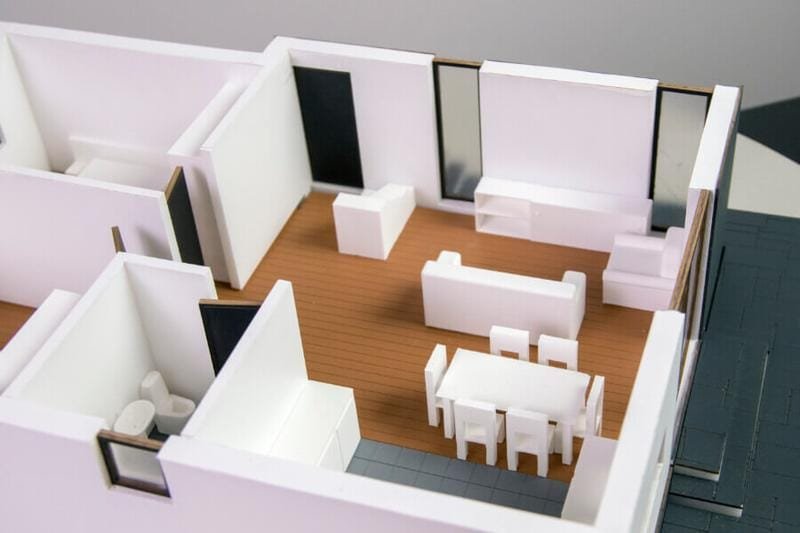
لقد أثرت التكنولوجيا بشكل عميق على كيفية تصميم وبناء النماذج الداخلية, تمكين قدر أكبر من الدقة, تعقيد, والكفاءة.
تصميم بمساعدة الكمبيوتر (كندي) & بيم
- مؤسسة الدقة: برامج مثل أوتوكاد, ريفيت, سكيتش اب, يوفر الكركدن المخطط الرقمي, ضمان دقة الأبعاد.
- تكامل BIM (ريفيت): يسمح للنماذج بأن تكون غنية بالبيانات, دمج معلومات حول المواد والمكونات خارج نطاق الهندسة فقط.
- قوة التصور: لتمكين العروض الواقعية والإرشادات الافتراضية قبل بدء البناء الفعلي.
التصنيع المضاف (3د الطباعة)
- التفاصيل والتعقيد: مثالية لإنشاء أثاث معقد, تركيبات مخصصة, العناصر الزخرفية, أو التفاصيل المعمارية المعقدة التي قد يكون من الصعب أو يستغرق وقتًا طويلاً صنعها يدويًا.
- السرعة والتكرار: تمكن النماذج الأولية السريعة لعناصر التصميم, السماح للاختبار السريع والصقل.
- خيارات المواد: من المواد البلاستيكية القياسية إلى الراتنجات عالية الدقة وحتى الطباعة بالألوان الكاملة, تقديم إمكانيات جمالية متنوعة.
تصنيع CNC & قطع الليزر
- قطع الدقة: يمكن لأجهزة التوجيه CNC طحن الخشب أو البلاستيك بدقة للأجزاء الهيكلية أو مكونات الأثاث. تتفوق قواطع الليزر في قطع المواد المسطحة بدقة مثل الأكريليك, خشب رقيق, أو البطاقات للجدران, flooring patterns, أو شاشات زخرفية.
- تناسق: يضمن التوحيد عند الحاجة إلى أجزاء متطابقة متعددة.
التصور المتقدم (الواقع الافتراضي/الواقع المعزز)
- تجارب غامرة: في حين أنها تختلف عن النماذج المادية, VR يتيح للمستخدمين عمليا “خطوة إلى الداخل” المساحة المصممة على نطاق كامل. يمكن للواقع المعزز تراكب المعلومات الرقمية على نموذج مادي. These technologies complement physical models by offering different ways to experience the design.
Presenting & Photographing Interior Models Effectively
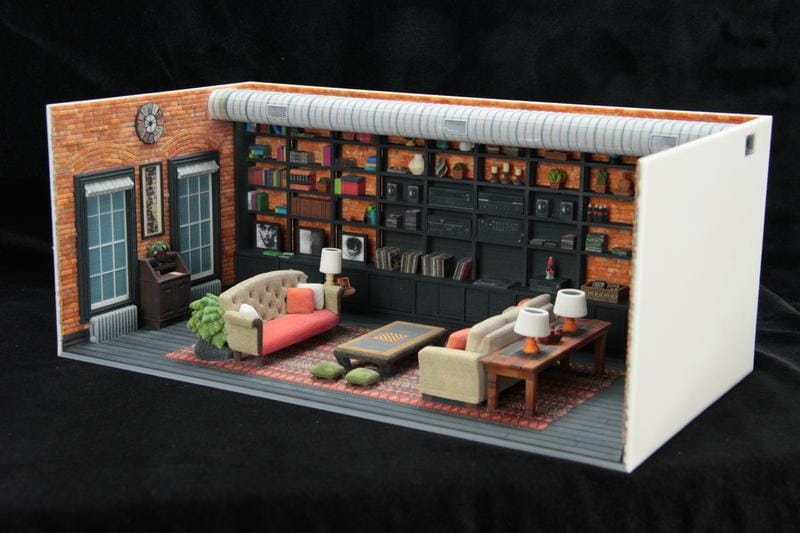
Creating a great model is only half the battle; presenting it effectively, especially through photography, is crucial for conveying its message. Here are tips specifically for documenting interior models:
Use Natural Light When Possible
- لماذا: Natural light reveals forms and material textures most clearly and accurately.
- Tip: An overcast day often provides soft, even light with gentle shadows, which is ideal. Direct sunlight can create dramatic but potentially obscuring shadows. Avoid harsh desk lamps that create unnatural color casts.
Photograph at Perceived Human Height
- لماذا: Since interiors are experienced by people, photographing the model from a low angle, كما لو كانت عدسة الكاميرا على مستوى العين داخل الفضاء, يوفر المنظور الأكثر صلة ومفهومة.
- Tip: استخدم كاميرا هاتفك الذكي; غالبًا ما يسمح لك حجمه الصغير بوضعه *داخل* النموذج لتحقيق وجهات نظر واقعية. تجنب الارتفاع المفرط, مناظر عين الطير ما لم توضح بشكل محدد التصميم العام.
أضف شخصيات بشرية للقياس
- لماذا: بما في ذلك الأرقام المقاسة (اسكتشات مقطوعة أو أشكال بلاستيكية تم شراؤها) يمنح المشاهدين على الفور فكرة عن حجم النموذج ونسب المساحة بالنسبة للأشخاص.
- Tip: وهذا مفيد بشكل خاص للنماذج المجردة أو عندما لا يكون السياق واضحًا على الفور.
كن استراتيجيًا مع اللون والملمس
- لماذا: إن محاولة تمثيل كل مادة ولون بشكل مثالي يمكن أن يجعل النموذج يبدو مشغولاً في بعض الأحيان أو مثل بيت الدمية, distracting from the core spatial idea.
- Tip: Consider using color or texture strategically to highlight specific zones, material changes, or key forms. Sometimes a monochrome model focusing purely on form and layout can be very effective.
Document Abstract Models and the Process
- Abstract Models: Don’t forget to photograph conceptual or abstract models exploring form, نَسِيج, or assembly. Shoot from various angles.
- Process Shots: Documenting the step-by-step construction can showcase techniques, reveal internal structures, or highlight effective earlier iterations.
Shoot Variety and Don’t Fear Editing
- Variety: Photograph the same model from multiple angles (overhead, eye-level, detail shots), in different lighting conditions, and with different backgrounds or added elements. You never know which view will be needed.
- Editing/Annotation: Simple edits can improve photos (على سبيل المثال, تحويل صورة ملونة سيئة الإضاءة إلى أبيض وأسود للتركيز على الشكل). الشروحات مباشرة على الصورة (التسميات, ملحوظات, شخصيات مرسومة) يمكن أن تضيف سياقًا قيمًا.
الجمع بين النماذج مع وسائل الإعلام الأخرى
- نموذج + رسم: قم بطباعة الصور وأشكال التصميم المختلفة مباشرة على تراكبات ورق التتبع, باستخدام منظور الصورة.
- رسم + نموذج: أضف عناصر ثلاثية الأبعاد مباشرة إلى نسخ الرسومات الفنية (خطط, أقسام) لاستكشاف التدخلات ثلاثي الأبعاد.
- نموذج + فوتوشوب: استخدم برامج تحرير الصور لإضافة مواد واقعية, حاشية, أو التأثيرات الجوية على صور النموذج المادي.
مواد & أدوات التجارة (مفصل)
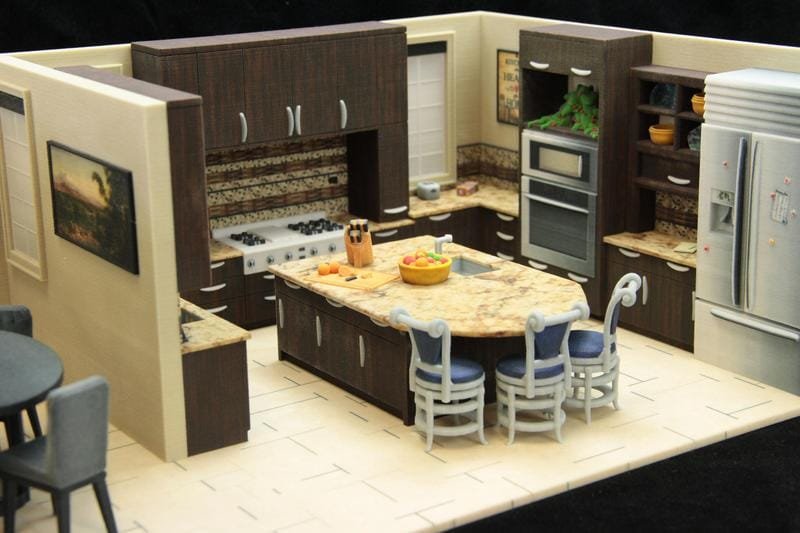
دعونا نعيد النظر في المواد والأدوات الأساسية مع مزيد من التفاصيل حول استخداماتها المحددة في صنع النماذج الداخلية.
إعادة النظر في المواد المشتركة
- لوح الرغوة/Foamcore: ممتاز للبناء السريع للجدران والهياكل الأساسية. من السهل قطعها بسكين حاد. سمك مختلف متاح. Good for massing studies.
- Cardstock/Chipboard/Museum Board: Versatile for walls, الأرضيات, simple furniture. Can be scored and folded. Comes in various thicknesses and colors. Can be used to represent finishes.
- البلسا وود: Very lightweight, extremely easy to cut and carve. Ideal for detailed furniture, trim work, architectural details. Takes paint and stain well but is fragile.
- Basswood/Other Woods: Stronger than balsa, still relatively easy to work with. Good for more durable furniture, العناصر الهيكلية, الأرضيات. Can be laser cut.
- Styrene Sheets/Strips/Shapes: Plastic material available in various thicknesses and profiles. Cuts easily (score and snap). Excellent for fine details, window/door frames, modern furniture. Bonds well with plastic cement.
- الأكريليك (زجاج شبكي): جامد, clear plastic perfect for representing glass windows, أقسام, display cases, or even water features. Requires specialized cutting tools (scoring knife, saw) or laser cutting.
- 3D Printing Filaments/Resins: جيش التحرير الشعبى الصينى, ABS, خيوط PETG لطابعات FDM (جيد للأجزاء الهيكلية, أثاث أكبر). راتنجات فوتوبوليمر لطابعات SLA/DLP (ضروري للمنمنمات عالية التفاصيل, الأشكال المعقدة).
- الأقمشة / المنسوجات: قطع صغيرة من القماش الفعلي أو مواد رقيقة لمحاكاة التنجيد, curtains, rugs. نسيج النطاق مهم.
- الدهانات & ينتهي: دهانات الأكريليك متعددة الاستخدامات. رش الدهانات لتغطية متساوية. دهانات موديلات محددة (المينا, اللك). الورنيش (ماتي, صقيل, لمعان) لمحاكاة لمعان السطح المختلفة. الدهانات أو الوسائط التركيبية.
- مواد لاصقة: غراء PVA (الخشب / الورق), الاسمنت البلاستيك (الستايرين), الغراء كاليفورنيا (الغراء الفائق – روابط سريعة, اللزوجة المختلفة), الايبوكسي (روابط قوية), رذاذ لاصق (الأسطح المسطحة الكبيرة).
إعادة النظر في الأدوات الأساسية
- حصيرة القطع: نوع الشفاء الذاتي يحمي الأسطح ويحافظ على حدة الشفرة.
- سكاكين: سكاكين حرفية حادة (أسلوب X-أكتو #11 الشفرات قياسية), سكاكين مفيدة للمواد الثقيلة, سكاكين التهديف للاكريليك. تعد التغييرات المتكررة للشفرة أمرًا أساسيًا لتنظيف الجروح.
- الحكام / المربعات: مساطر معدنية مع دعم الفلين (يمنع الانزلاق), حكام النطاق, ساحات المهندسين الصغيرة, الجمع بين المربعات للتأكد من دقتها.
- أجهزة القياس: الفرجار (الرقمية أو الاتصال الهاتفي) لقياسات دقيقة, شريط قياس مرن.
- أدوات الصنفرة: كتل الصنفرة, عصي الصنفرة, فريك مختلفة من ورق الصنفرة, ملفات صغيرة لتشكيل وتنعيم الحواف.
- المشابك / الملقط: المشابك الصغيرة, المشابك الربيع, ملاقيط (أنواع مختلفة – وأشار, مستوي, العمل العكسي) لعقد الأجزاء أثناء الإلتصاق أو تحديد المواقع.
- معدات السلامة: تعتبر نظارات السلامة ضرورية عند القطع أو استخدام الأدوات الكهربائية. قناع الغبار عند الصنفرة. التهوية الجيدة عند الطلاء أو استخدام مواد لاصقة قوية.
- أدوات كهربائية اختيارية: رأى التمرير الصغيرة, منشار طاولة صغير, أداة دريميل الدوارة (لطحن, تلميع, قطع), قطع الليزر, 3طابعة د.
التحديات المشتركة & حلول في صنع النماذج الداخلية
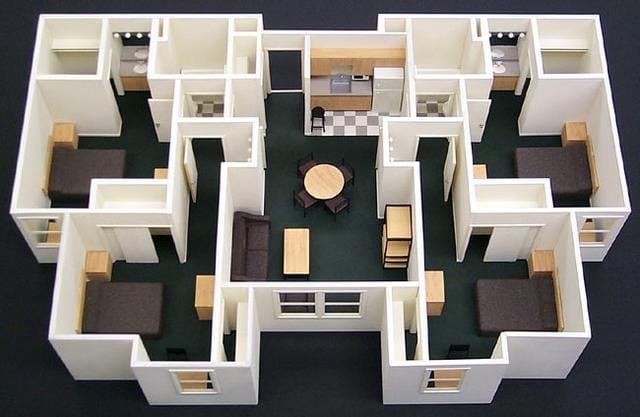
يأتي إنشاء نماذج داخلية مفصلة مع مجموعة من التحديات المحددة. فيما يلي نظرة على العقبات الشائعة وكيفية التغلب عليها من قبل صانعي النماذج ذوي الخبرة.
تحدي: تحقيق التفاصيل على نطاق صغير
- The Issue: Replicating intricate furniture details, المباريات, or decorative patterns accurately when everything is miniaturized. Features can become too small to physically create or appear crude.
- Solutions: Use high-resolution fabrication methods like SLA/DLP 3D printing. Employ fine tools and magnification. Simplify non-essential details strategically. Focus on conveying the *impression* of detail rather than exact replication sometimes. Choose an appropriate (often larger) scale for highly detailed projects.
تحدي: Realistic Material Representation
- The Issue: It’s difficult to find miniature materials that perfectly mimic the texture, sheen, and grain of full-scale materials like wood, حجر, قماش, أو المعدن. Applying finishes consistently can also be tricky.
- Solutions: Skillful painting and texturing techniques are key (dry brushing, يغسل, تنقيط). Use actual material samples where feasible (thin wood veneers, fine fabrics). Print high-resolution textures onto paper or decal film to apply to surfaces. Select materials carefully based on how well they simulate the real thing at scale.
تحدي: Color Accuracy and Lighting Representation
- The Issue: Colors can appear different under model lighting or at a smaller scale. Accurately simulating the quality and effect of both natural and artificial light within the model is complex.
- Solutions: Use color swatches and test paints under the intended display lighting. Understand color theory and how scale affects perception. Plan lighting integration carefully, using appropriate miniature LEDs and diffusers. Consider building small lighting mock-ups.
تحدي: Balancing Durability with Fine Details
- The Issue: Highly detailed models with delicate parts (thin furniture legs, small accessories) can be very fragile and easily damaged during handling or transport.
- Solutions: Use stronger materials for structural elements (على سبيل المثال, acrylic instead of cardstock). Design connections carefully. Consider slightly thickening very fine parts if possible without compromising aesthetics. Provide a sturdy base and a protective acrylic cover. Advise clients on proper handling procedures.
تحدي: Maintaining Spatial Accuracy and Scale Consistency
- The Issue: Ensuring all elements – walls, أثاث, fixtures – are consistently and accurately scaled relative to each other. Even small errors can distort the perception of the space.
- Solutions: Work meticulously from accurate plans and measurements. Use precise cutting and measuring tools. Double-check scales frequently during construction. Employ CAD and automated fabrication (الليزر, 3D print) where possible for consistent part sizing.
Overcoming these challenges requires a combination of technical skill, artistic sensibility, الصبر, and careful planning.
Understanding the Costs of Interior Models
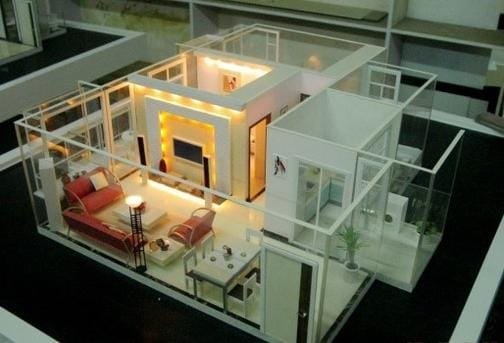
The investment required for an interior model varies widely. Several factors influence the final price:
Key Factors Influencing Cost
- Size and Scale: Larger models naturally require more materials and labor. موازين أكبر (على سبيل المثال, 1:10 مقابل 1:50) allow for more detail but also increase complexity and material usage.
- Level of Detail and Complexity: Highly detailed models with intricate furniture, تركيبات مخصصة, complex geometry, and realistic finishes take significantly more time and skill to create.
- التفاعل: Adding functional lighting, أجزاء متحركة, or other interactive elements increases cost due to components and specialized labor.
- المواد المستخدمة: High-quality materials like acrylic, certain woods, المعادن, or specialized 3D printing resins are more expensive than basic foam board or cardboard.
- Fabrication Techniques: Extensive use of 3D printing or CNC machining can impact cost compared to simpler hand-cutting methods (though may save time).
- Labor and Expertise: The time and skill level of the model makers are major cost drivers. Complex projects require experienced artisans.
- الجدول الزمني: Rush jobs requiring overtime will typically incur higher costs.
- Design Changes: Significant changes requested after construction has begun can lead to additional costs.
- Base and Protective Casing: A custom display base and acrylic cover add to the overall cost.
Example Cost Ranges
Article 4 provides some specific (though potentially indicative) cost estimates. It’s crucial to get custom quotes, but these offer a general idea:
| نوع النموذج / Scope | Estimated Cost Range (دولار أمريكي) | Estimated Cost Range (EUR approx.) | Estimated Cost Range (GBP approx.) |
|---|---|---|---|
| Simple DIY House Model (Basic Rooms) | $300 – $500 | €270 – €450 | £230 – £385 |
| Finished DIY House Model (Higher Grade) | $800 – $1,500 | €720 – €1,350 | £615 – £1,150 |
| Professional House Model (مفصل) | $2,000 – $3,000+ | €1,800 – €2,700+ | £1,540 – £2,300+ |
| Basic DIY Living Room Model | $50 – $100 | €45 – €90 | £38 – £77 |
| Mid-Range DIY Living Room Model | $300 – $500 | €270 – €450 | £230 – £385 |
| Professional Living Room Model | $1,000 – $2,000+ | €900 – €1,800+ | £770 – £1,540+ |
| Basic DIY Bathroom Model | $50 – $75 | €45 – €68 | £38 – £58 |
| Realistic DIY Bathroom Model | $200 – $300 | €180 – €270 | £153 – £230 |
| Professional Bathroom Model | $1,000 – $1,500+ | €900 – €1,350+ | £770 – £1,150+ |
| Basic DIY Kitchen Model | $100 – $150 | €90 – €135 | £77 – £115 |
| Realistic DIY Kitchen Model | $300 – $500 | €270 – €450 | £230 – £385 |
| Professional Kitchen Model | $1,500 – $2,000+ | €1,350 – €1,800+ | £1,150 – £1,540+ |
| General Professional Range | $1,000 – $250,000+ | €900 – €225,000+ | £750 – £190,000+ |
Note: These are illustrative ranges based on one source. Actual costs will vary significantly based on the factors listed above. The large general range reflects the vast difference between simple massing models and extremely high-end, detailed presentation models.
DIY مقابل. احترافي
As the table shows, DIY models can be significantly cheaper in terms of material cost but require substantial time, مهارة, and tools. Professional models command higher prices but offer expertise, access to advanced technology, higher quality finishes, and save the client’s time.
Software Used in Interior Modeling
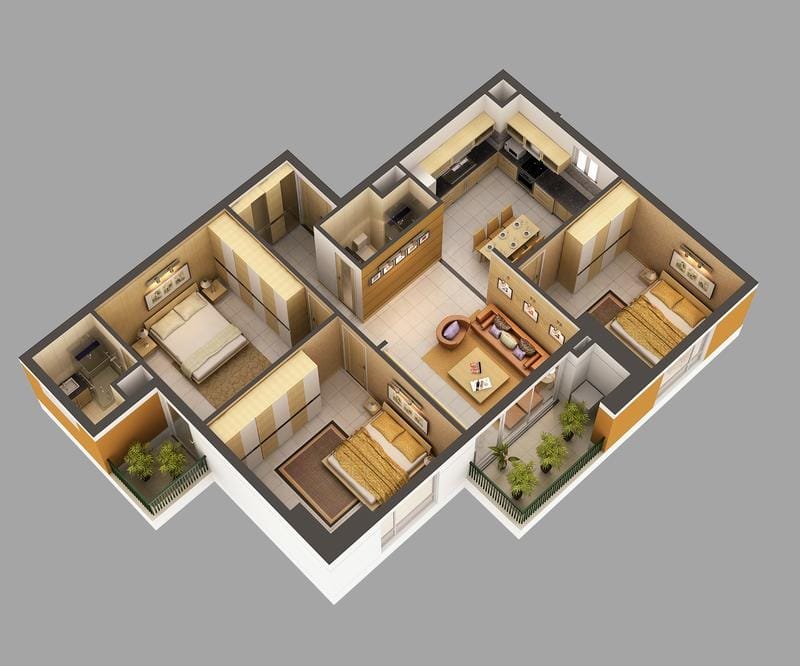
While physical models are the focus, digital tools play a crucial role in their design and often in generating components for fabrication. Common software includes:
- سكيتش اب: Popular for its intuitive interface and ease of creating 3D forms quickly. Widely used for conceptual and schematic interior modeling. Large component library (3D Warehouse).
- أوتوكاد: Industry standard for precise 2D drafting (floor plans, الارتفاعات) and also offers robust 3D modeling capabilities, especially for architectural elements.
- ريفيت: نمذجة معلومات البناء (بيم) برمجة. Creates intelligent, data-rich models where components have associated information. Excellent for integrated design including MEP systems.
- 3س ماكس: Strong in detailed modeling, النسيج, and especially high-end, photorealistic rendering of interior scenes. Often used for visualization alongside physical models.
- وحيد القرن (Rhinoceros 3D): Powerful freeform NURBS modeling software, excellent for creating complex curves and custom furniture shapes with high precision.
- Adobe Photoshop: Used for creating or editing textures, post-processing renderings, or adding annotations/graphics to photos of physical models. Interior Model Making
The craft continues to evolve, blending tradition with innovation:
- Digital Integration (الواقع الافتراضي/الواقع المعزز): Expect more seamless integration between physical models and digital overlays or immersive virtual experiences.
- Advanced Materials & 3د الطباعة: Continued development of materials that offer greater realism, متانة, or unique properties. More sophisticated multi-material and full-color 3D printing.
- التركيز على الاستدامة: Increased use of eco-friendly, recycled, or biodegradable materials and more resource-efficient fabrication processes.
- Hyper-Personalization: Technology like 3D scanning and printing makes it easier to create highly customized models, perhaps even replicating a client’s existing furniture in miniature.
- Data-Driven Design Input: Potential for models to be informed by or interact with data analytics regarding space utilization or environmental performance.
- Enhanced Collaboration Tools: Digital platforms facilitating easier collaboration around both digital and physical model reviews.
Choosing the Right Interior Model Maker
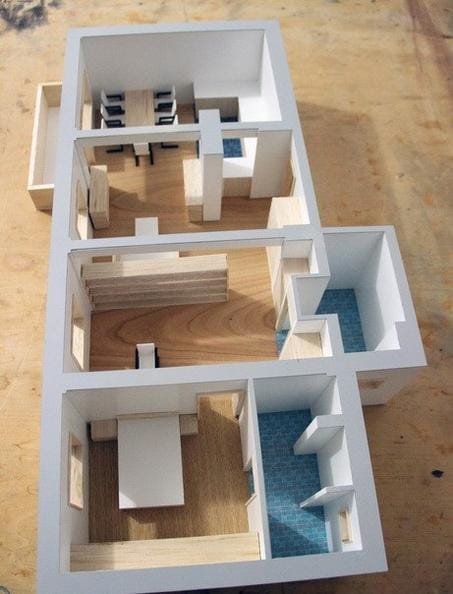
Finding the right partner is key to getting a model that truly serves its purpose. Consider these factors:
- Specialization in Interiors: Look for a maker with demonstrated experience and understanding of interior spaces, أثاث, وينتهي, not just exterior architecture.
- جودة الحافظة: Critically assess their past interior work. Does it show the level of detail, الواقعية, and craftsmanship you require?
- Technical Capabilities: Do they possess the necessary tools and technologies (high-res 3D printing, القطع بالليزر, finishing expertise) for your project’s complexity?
- Understanding of Design Intent: Can they grasp and translate your specific design aesthetic, material choices, and desired ambiance?
- Communication and Process: Do they have a clear communication process? How do they handle feedback and revisions?
- Material Expertise: Do they demonstrate knowledge in selecting and simulating a wide range of interior materials convincingly?
- الاهتمام بالتفاصيل: Is meticulousness evident in their work? Interiors often live or die by the details.
- References and Reputation: Check reviews or ask for client references if possible.
خاتمة: The Enduring Value of Seeing Inside
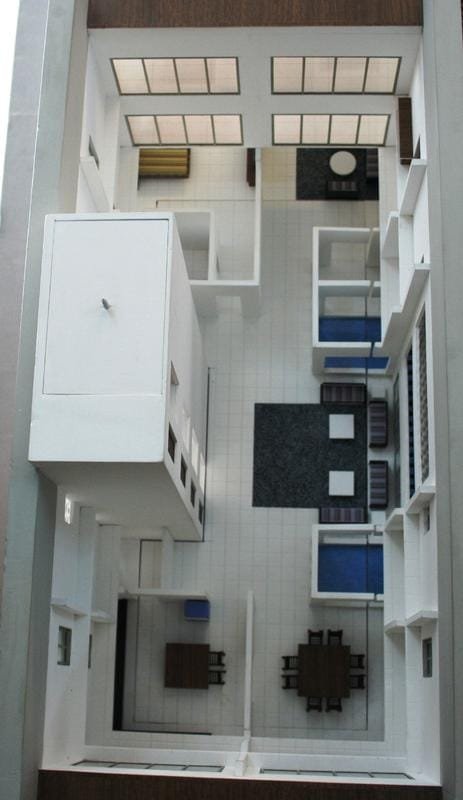
In the complex world of architecture and interior design, the ability to clearly visualize and communicate spatial ideas is paramount. Interior models provide an unparalleled solution, transforming abstract plans into tangible realities that can be explored, evaluated, and refined.
They bridge communication gaps, empower clients, reduce costly errors, and serve as powerful marketing assets. While digital tools offer incredible capabilities, the physical interior model retains a unique power to engage the senses, foster intuitive understanding, and build confidence in a design. By combining skilled craftsmanship with appropriate technology, interior models effectively bring proposed spaces to life, ensuring that the final built environment truly meets the vision and needs of its users. إنهم ليسوا مجرد تمثيلات; they are essential instruments for achieving design excellence.
الأسئلة المتداولة (FAQs) About Interior Models
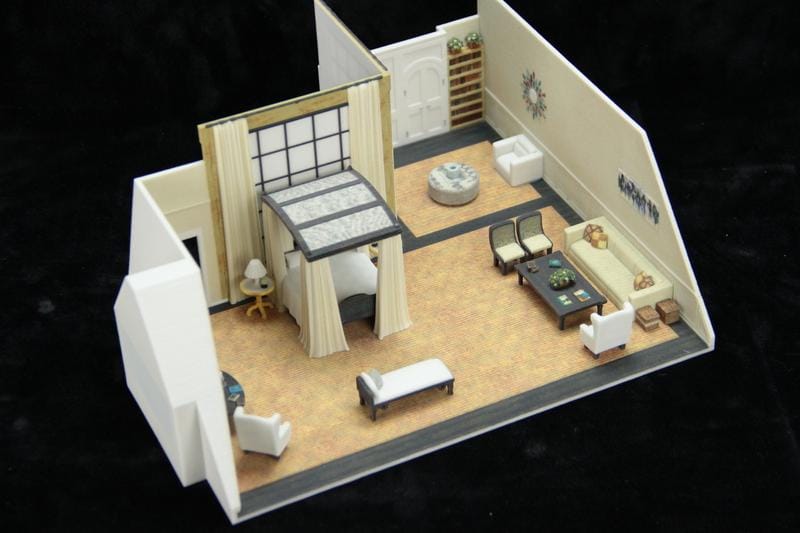
Here are answers to common questions regarding interior models:
- What materials are typically used for architectural interior models?
- Common materials include foam board, كرتون, various woods (like balsa or basswood), البلاستيك (الستايرين, أكريليك), 3D printed resins/plastics, fabric samples, and specialized paints and finishes.
- How do interior models help in client presentations?
- They provide a tangible, 3D view that clients can easily understand, interact with, and relate to, making discussions more productive and decisions more confident compared to relying solely on drawings or digital images.
- Can interior models be created digitally instead of physically?
- نعم, digital 3D modeling is very common using software like SketchUp or Revit. لكن, physical models offer unique benefits in tactile exploration and immediate spatial understanding that digital models can lack.
- How can interior models contribute to sustainable design?
- Models can help visualize and evaluate aspects like natural light penetration, ventilation paths, and the placement of sustainable materials, aiding architects in optimizing designs for energy efficiency and environmental performance.
- Are interior models only used for new construction projects?
- لا, they are also very useful for renovation, restoration, and alteration projects to help visualize proposed changes and improvements within existing spaces.
- What scale is best for an interior model?
- Scales typically range from 1:10 ل 1:50 to allow for sufficient detail in furniture and finishes. The choice depends on the project size and the level of detail required.
- How much does an interior model cost?
- Costs vary widely based on size, التفاصيل, مواد, interactivity, and labor. It can range from under $100 for a simple DIY model to hundreds of thousands for large, hyper-realistic professional presentation models. Custom quotes are essential.
- What kind of architect typically creates interior models?
- While many architects create basic models, specialized *Interior Architects* or dedicated architectural model making firms often have the specific skills and focus required for high-quality, نماذج داخلية مفصلة


